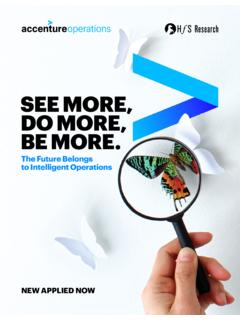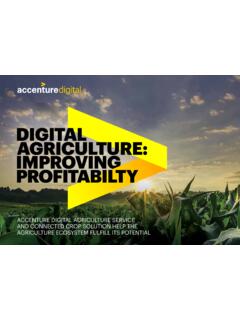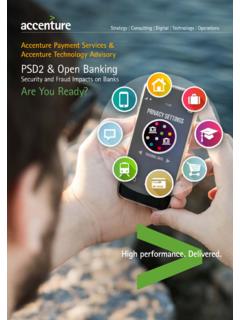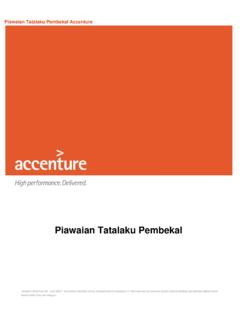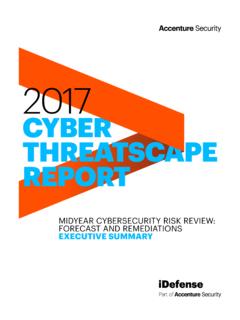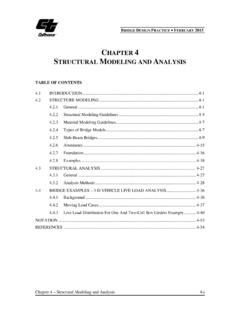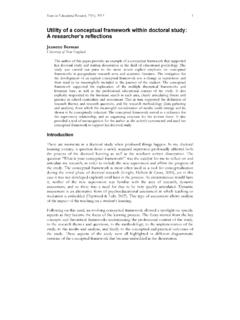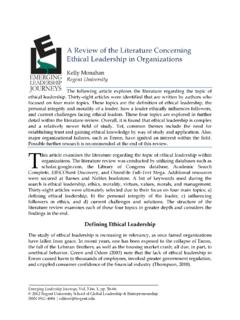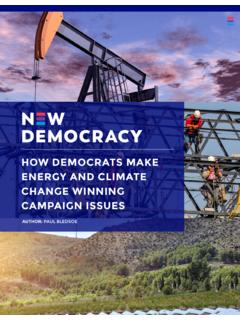Transcription of There are many important moments during a customer’s ...
1 2 moments THAT MATTER | COPYRIGHT 2017 ACCENTURE. ALL RIGHTS are many important moments during a customer s tenure with a brand. Customers are continuously considering and evaluating which new and latest services and products are best suited for themselves or their families. Customers make purchases, modify and upgrade existing services and devices. They repeatedly monitor the usage of their service plans, manage their accounts, and pay monthly bills. Should a question or issue arise, they seek an answer or a speedy resolution to their problem. These moments of engagement between customer and brand are called moments of Truth. While There are many moments of Truth across a customer s interaction with a brand, certain moments are likely to have a more significant impact than others on a customer s level of happiness with the brand.
2 These defining moments are called moments THAT MATTER. 3 moments THAT MATTER | COPYRIGHT 2017 ACCENTURE. ALL RIGHTS today s increasingly competitive environment where customer expectations continue to rise, it is essential to get these moments that Matter (MTM) right. Brands can maximize returns on their investments by choosing to focus time and energy on a few meaningful moments with their customers. But which moments matter most to customers? What impact do these key moments that Matter have on customer sentiment and loyalty towards a brand? What should brands do to deliver experiences that evoke positive emotions? To help answer these questions, Accenture conducted research to understand what drives loyalty and how a brand can impact their customers emotional connectedness.
3 In recently published research, Accenture introduced a brand-specific measurement of customer loyalty called the Keep Me Index (KMI) which measures the emotional connection between a customer and brand and the impact of that connection on loyalty. 4 moments THAT MATTER | COPYRIGHT 2017 ACCENTURE. ALL RIGHTS further analyzed this research to learn more about moments of engagement, channel behaviors, and the impact that various experiences can have on customers. This report introduces a new (but related) measurement called the Individual Keep Me Index (iKMI), which measures a customer s influence on a brand s KMI. Accenture analyzed the relationship between a customer s last moment that Matters, their individual influence on KMI (or iKMI), and their brand loyalty (likeliness to stay).
4 THREE KEY DISCOVERIES emerged from Accenture s research and analysis:WHERE TO FOCUS: There are moments that matter most WHEN TO FOCUS: The last moment leaves a mark HOW TO FOCUS: The moment must haves are customer flexibility and choiceFour key moments provide the greatest opportunity for a brand to evoke customer emotion. 5 moments THAT MATTER | COPYRIGHT 2017 ACCENTURE. ALL RIGHTS RESERVED. THE moments THATIn Accenture s annual Global Consumer Pulse Research (GCPR), 43% of customers indicated that their brand loyalty is heavily influenced by customer service Where brands often struggle is finding the critical places in which to invest to create lasting and meaningful experiences, maximizing loyalty to this latest research study were asked to identify the moments that they feel most impacts their level of happiness as a customer of their service provider.
5 Four specific moments emerged from the pack as the moments that matter: 1. Resolving a service or technical question or issue 2. Paying a bill3. Upgrading or changing service or a device4. Resolving a billing question or issueThese moments come at different points in the customer lifecycle and represent the key moments that Matter that are imperative for brands to get right in order to most effectively impact customer happiness and a service or technical question / issueResolving a billing question / issuePaying a billInstalling / activatingBrowsingDown-gradingPurchasing new service or deviceCheckingusageUpgrading / changing service or a deviceFIGURE 1 Percent of respondents who ranked each moment as most impactful on their level of happinessMoments that Matter have a direct and lasting impact on sentiment and moments THAT MATTER | COPYRIGHT 2017 ACCENTURE.
6 ALL RIGHTS RESERVED. THE LAST MOMENTAs demonstrated in Accenture s KMI report, There is a strong correlation between a brand s KMI and customer loyalty. Further analysis also shows a strong correlation between a customer s last moment that Matters, his individual influence on KMI (or iKMI), and his likeliness to stay loyal to a brand. If the customer s last moment that Matters was positive, sentiment and loyalty were higher; if it was negative, sentiment and loyalty were lower. What s most interest-ing, however, is that a positive moment has the strongest influence on loyalty, while a negative moment has the strongest influence on what customers think, feel and say about a brand (iKMI).FIGURE 2 Correlation between ending emotion of last MTM and Loyalty (a positive MTM greatly influences loyalty, and a negative MTM greatly influences iKMI)4%-26%51%21%78%57%NegativeNeutralPo sitiveEnding emotion of last MTM100%80%60%40%20%-20%0%AVERAGE LOYALTY(likeliness to stay 12 months)AVERAGE iKMIU nsureLikely to stayCorrelation between ending emotion of last MTM and Loyalty(a positive MTM greatly influences Loyalty, and a negative MTM greatly influences iKMI)77%38%39%of consumers feel a brand earns their loyalty if they take immediate action when they are consumers shifted some spend elsewhereimmediately stopped doing business with the brandAfter a bad moments THAT MATTER | COPYRIGHT 2017 ACCENTURE.
7 ALL RIGHTS reinforces the power of positivity: The last moment be it customer or brand initiated MUST evoke positive emotion. Accenture s GCPR research found that 77% of customers feel a brand earns their loyalty if they take immediate action when they are unhappy. Reversely, the same study found that, after a bad experience, 38% of customers shifted a portion of their spend to another provider and another 39% immediately stopped doing business with the By proactively and reactively providing experiences that delight, brands can be confident they are increasing their customers likelihood of loyalty as well as retaining (if not growing) their customer findings are corroborated by Accenture's GCPR Research, which also found that There is power in positivity and risk in moments THAT MATTER | COPYRIGHT 2017 ACCENTURE.
8 ALL RIGHTS flexible, dynamic, persistent experience is a must have for brands to drive higher iKMI and profitability. moment MUST HAVES: Brands must provide channel CHOICE vary. Each respondent was asked to reflect on the last time he engaged with his service provider to complete his chosen moment that Matters. Which channel did they use first to initiate that moment ? While the results showed diversity of channel choices across human, physical and digital channels, There were also clear behavioral patterns that align to the various moments that brands should incorporate into their channel strategy (See Figure 3).Reasons vary. There were many reasons why customers initially chose one channel over another. While convenience was the top reason customers chose a particular channel, customers perception of convenience is clearly subjective given it ranked first across all channel types human, physical and digital.
9 Customers were happiest when a provider s experience allowed them to accomplish what they intended to do when, where and how they chose to do vary. Data also showed that the experience a customer had in the first channel and the outcome of that channel engagement impacts their subsequent channel choice. Regardless of the first channel type, if a moment was not resolved in that first channel, the average customer (56%) turned next to a live agent. Why? Nearly half were told to or felt they had no other option. Most others wanted an opportunity to ask, explain, reason or negotiate, or thought going to a human would be the fastest method. Brands must connect those channel options for FLEXIBILITYIt s not enough to simply provide channel options to appease a variety of customer preferences, reasons and intentions.
10 75% of consumers indicated they expect to be able to use multiple channels to complete a moment , picking up where they left off, without having to start over or repeat Furthermore, the research found that customers who use multiple channel types to complete a moment have a iKMI 12X higher and are typically 15-25% more profitable1 than human-, digital-, or physical-only customers! For issue resolution, customers more often turned to live agents (76% FOR SERVICE ISSUES; 83% FOR BILLING ISSUES). For moments that occur more regularly (like paying a bill, checking usage information), a majority of customers chose digital channels. (62% FOR PAY BILL; 69% CHECK USAGE)For moments that involved shopping, PURCHASING OR UPGRADING services or devices, customers first channel choice was EQUALLY DISTRIBUTED ACROSS HUMAN, DIGITAL AND PHYSICAL.
